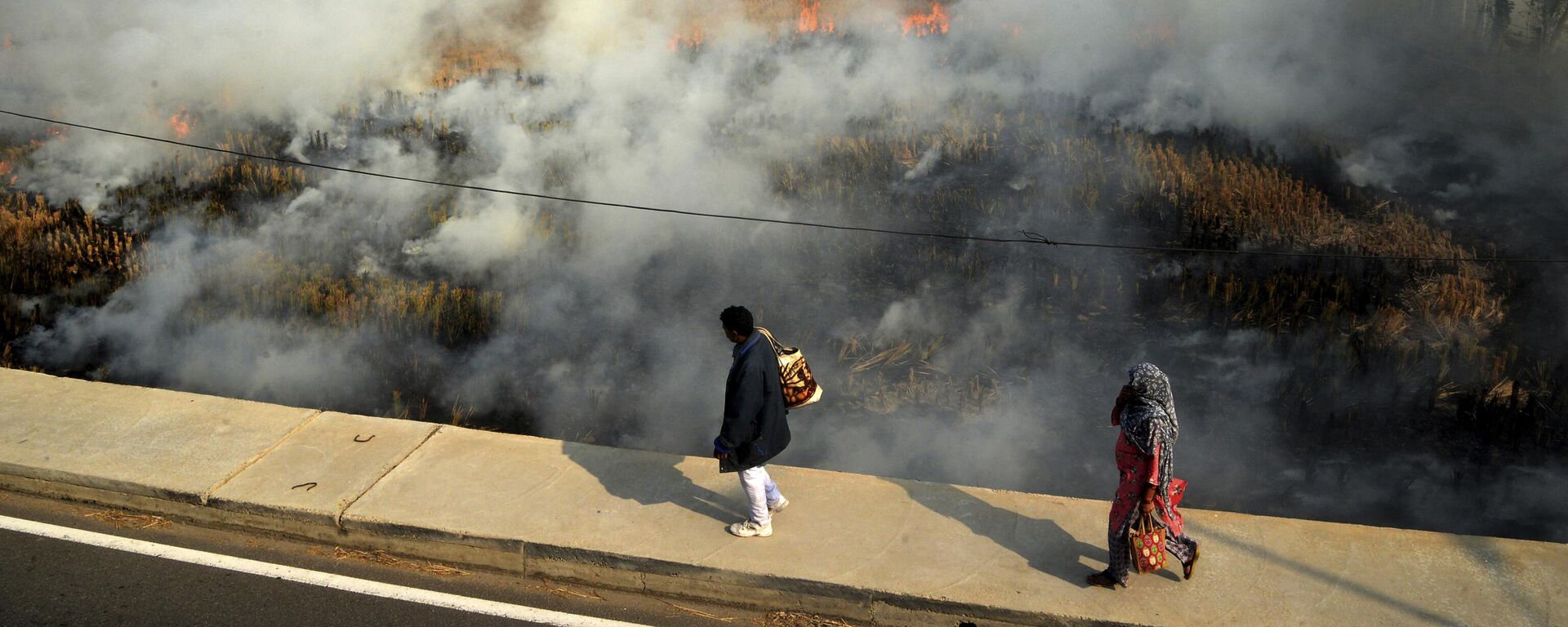https://sputniknews.in/20230603/indias-coal-demand-to-peak-in-a-decade-if-renewable-targets-not-met-experts-warn-2284412.html
India's Coal Demand to Peak in a Decade If Renewable Targets Not Met, Experts Warn
India's Coal Demand to Peak in a Decade If Renewable Targets Not Met, Experts Warn
Sputnik India
One of the countries driving the global consumption of both types of coal will be India. We estimate that by 2050 this country will increase thermal coal consumption by 30% compared to 2021 levels.
2023-06-03T12:00+0530
2023-06-03T12:00+0530
2023-06-03T12:00+0530
india
coal production
sputnik exclusives
international energy agency (iea)
renewable energy
clean energy
energy transition
green energy
energy crisis
https://cdn1.img.sputniknews.in/img/07e7/06/02/2298508_0:160:3072:1888_1920x0_80_0_0_1f256a653c51638647c3a012bc1f1552.jpg
Global coal consumption in 2030 and 2050 will be higher than International Energy Agency (IEA) forecasts, consulting company Yakov and Partners has claimed in a study reviewed by Sputnik.It also reports that India will be one of the countries stimulating a higher global consumption.As per Yakov and Partners, the world's thermal coal consumption is expected to grow by three percent from 6.8 billion tons in 2021 to 7 billion tons in 2030. At the same time, the trend will have reversed by 2050, with a decrease of 38% to 4.2 billion tons.The report claims that demand for coal will mainly come from the fast-growing economy of India, as well as other developing countries in Asia and Africa.Meanwhile, in the EU, "The total demand for coal - both energy and coking - will decrease by 8 [or] 9 by 2050 relative to the level of 2021 and will amount to only 48 million tons. This will reflect the turbulent development of renewable energy sources and changes in several industries, such as the automotive industry," the study reports.Sputnik spoke with India-based experts who shared their views on the country's current consumption and how it plans to phase out the black fuel."Everything is dependent on demand. If demand grows less than five percent (annually), it can be achieved via solar, and coal demand might lead to a plateau," he explained. Countries Need to Reduce Coal ConsumptionAnother expert, Sunil Dahiya, an analyst at the Centre for Research on Energy and Clean Air, said: "If we go as per IPCC 1.5 degree goal -- global coal consumption has to decline by 2030 in developed countries and 2040 in developing countries. We won't achieve the target if countries fail to reduce coal use."Dahiya said that in countries like India, the cost of coal is as much as the cost of using renewable energy, but that the latter is expected to fall as the industry scales up.Dahiya expected coal demand to peak earlier than 2030.Dahiya concluded by arguing that developed nations owe a responsibility to the poor nations of the Global South and should come forward and help smaller countries with technology and economic assistance.
https://sputniknews.in/20230525/cop-loss--damage-fund-need-of-the-hour-for-climate-change-hit-nations-2140180.html
https://sputniknews.in/20230328/in-search-of-solutions-for-deteriorating-air-pollution-in-south-asia-1331832.html
india
Sputnik India
feedback.hindi@sputniknews.com
+74956456601
MIA „Rossiya Segodnya“
2023
Deexa Khanduri
https://cdn1.img.sputniknews.in/img/07e6/0c/13/138923_52:0:533:481_100x100_80_0_0_cadf23d341691fc65ff2b22fd1afe584.jpg
Deexa Khanduri
https://cdn1.img.sputniknews.in/img/07e6/0c/13/138923_52:0:533:481_100x100_80_0_0_cadf23d341691fc65ff2b22fd1afe584.jpg
News
en_IN
Sputnik India
feedback.hindi@sputniknews.com
+74956456601
MIA „Rossiya Segodnya“
Sputnik India
feedback.hindi@sputniknews.com
+74956456601
MIA „Rossiya Segodnya“
Deexa Khanduri
https://cdn1.img.sputniknews.in/img/07e6/0c/13/138923_52:0:533:481_100x100_80_0_0_cadf23d341691fc65ff2b22fd1afe584.jpg
india's coal demand, india's coal production, how much coal demand in india, has india coal production increased, why is india using so much coal, is india the largest consumer of coal, what country buys the most coal, who buys the most coal, is india the second largest consumer of coal, which country is the largest consumer of coal, is india the second largest consumer of coal, what is the rank of india in the world in coal, is india the largest producer of coal, world's thermal coal consumption,
india's coal demand, india's coal production, how much coal demand in india, has india coal production increased, why is india using so much coal, is india the largest consumer of coal, what country buys the most coal, who buys the most coal, is india the second largest consumer of coal, which country is the largest consumer of coal, is india the second largest consumer of coal, what is the rank of india in the world in coal, is india the largest producer of coal, world's thermal coal consumption,
India's Coal Demand to Peak in a Decade If Renewable Targets Not Met, Experts Warn
Deexa Khanduri
Sputnik correspondent
As of 2022-23, 73 percent of India's power is generated by coal. Despite experts' projections, the Ministry of Power's Central Electricity Authority (CEA) expects that this will fall by 55 percent by 2030.
Global coal consumption in 2030 and 2050 will be higher than International Energy Agency (IEA) forecasts, consulting company Yakov and Partners has claimed in a study reviewed by Sputnik.
It also reports that India will be one of the countries stimulating a higher global consumption.
As per Yakov and Partners, the world's thermal coal consumption is expected to grow by three percent from 6.8 billion tons in 2021 to 7 billion tons in 2030. At the same time, the trend will have reversed by 2050, with a decrease of 38% to 4.2 billion tons.
The report claims that demand for coal will mainly come from the fast-growing economy of India, as well as other developing countries in Asia and Africa.
"One of the countries driving the global consumption of both types of coal [energy and coking] will be India. We estimate that by 2050, this country will increase thermal coal consumption by 30% compared to 2021 levels, and the consumption of metallurgical coal could jump more than 4 times. This is due to the growth of the economy and the increase in the country's population," the report projects.
Meanwhile, in the EU, "The total demand for coal - both energy and coking - will decrease by 8 [or] 9 by 2050 relative to the level of 2021 and will amount to only 48 million tons. This will reflect the turbulent development of renewable energy sources and changes in several industries, such as the automotive industry," the study reports.
Sputnik spoke with India-based experts who shared their views on the country's current consumption and how it plans to phase out the black fuel.
"If you look statistically at the National Electricity Plan, the draft version which was released last September to December, and at the new optimum generation capacity mix report, you will see that coal generation is likely to increase by almost one to 1.5% every year for the next 10 years. However, most modeling suggests that solar [energy] will meet most of the demand," Aditya Lolla, Asia program lead at India's state-run renewable energy target tracker Ember, told Sputnik.
"Everything is dependent on demand. If demand grows less than five percent (annually), it can be achieved via solar, and coal demand might lead to a plateau," he explained.
"So a 30% rise since 2018 (to 2050) is gradual growth. It's not a quick spike. And, if you look at it from a relative point of view, the share of coal in the overall energy mix will fall," Lolla added.
Countries Need to Reduce Coal Consumption
Another expert, Sunil Dahiya, an analyst at the Centre for Research on Energy and Clean Air, said: "If we go as per IPCC 1.5 degree goal -- global coal consumption has to decline by 2030 in developed countries and 2040 in developing countries. We won't achieve the target if countries fail to reduce coal use."
Dahiya said that in countries like India, the cost of coal is as much as the cost of using renewable energy, but that the latter is expected to fall as the industry scales up.
"This is not just for India. In coming times, coal costs will increase and not be economically viable for most of the countries in South Asia. And, in this, we are not even adding the health and environmental hazards created by coal," Dahiya explained.
Dahiya expected coal demand to peak earlier than 2030.
"As per my estimate, coal consumption in India will peak in 2026. If we meet our renewable energy target, we don't need to worry, but coal usage will increase if we fail to meet our renewable target [to install 450 MW by 2030]," he said.
Dahiya concluded by arguing that developed nations owe a responsibility to the poor nations of the Global South and should come forward and help smaller countries with technology and economic assistance.




